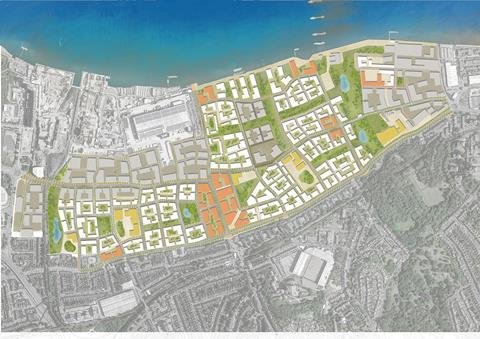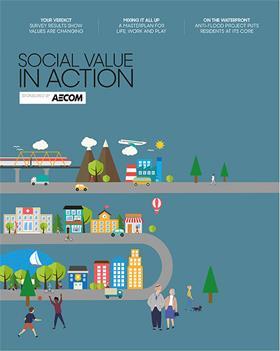On 20ha at Charlton Riverside, a new masterplan aims to provide local people with somewhere to live, work and play â with the hope that this mixed-use model holds wider lessons for London. Debika Ray reports

âOften when a major developer works in an area, it tries to create a new identity to set the place apart from whatâs around it and build as much housing as possible, to create higher financial value,â says Aecom director Patrick Clarke. âIn the case of Charlton Riverside, it was about creating a place that reflects the identity of the existing area and community. We wanted to celebrate its mix of uses and activities as a strength, not a weakness.â
Between 2015 and 2017, Clarke and his fellow director Mark Hughes worked as part of a team with the Royal Borough of Greenwich to develop a masterplan and planning guidelines to shape this little corner of south-east London. The site of Charlton Riverside is a complex one with competing demands, where the local community had become progressively hemmed in by busy roads that cut them off from the River Thames.

When Aecom came to the project, there were a host of expectations as to what the site would deliver in terms of jobs and affordable homes, but there was no coherent sense of how to achieve those objectives. So, how did the team set about not just fulfilling the aims for the site but also clarifying those aims in the first place?
Complex issues
Among the siteâs complex issues were contradictions in the status of the land, for example the fact that it had been earmarked for mixed-use development but was also designated as strategic industrial land. Adding to the complexity were immovable obstacles such as the presence of a gravel distribution industry in the area and the need to retain open access to the Thames Barrier, a piece of significant regional infrastructure that is crucial to prevent flooding.
While the status of this 20ha site hovered in uncertainty, piecemeal efforts at development had been taking place around the edges, resulting in an awkward mix of supermarkets and retail buildings that would seem more at home on the edge of a town rather than in the middle of a London borough. The council decided it needed a concrete plan that would give direction to potential developers, as the land was freed up from its former industrial designation.
This was about providing an environment where people would choose to live and put down roots
Mark Hughes, Aecom
Aecomâs masterplan and supplementary planning document have ended up as a blueprint for all future planning decisions on the site. These documents acknowledge the need for more affordable housing in Charlton â the council was particularly keen that half of all these should be family homes, with more than two bedrooms â but also emphasise other priorities, including employment, open space, facilities to develop skills and for higher education, the provision of shops and local services, and the need to reconnect Charltonâs community to the riverside and improve the streetscape.
Centring local peopleâs needs
At the heart of all these plans is the notion of social value. While nearby Woolwich Arsenal and Greenwich Peninsula have followed a more typical development route, being populated by high-rise housing that responds to market demand, the council wanted Charlton to place the needs of its existing residents at its heart. In creating its proposal, Aecom has strived to redefine what âvalueâ means in these cases â how it is calculated and to whom and what it is ascribed. âWe wanted Charlton to be somewhere local people would want to live in, not somewhere full of high-rise apartment blocks for international investors,â Clarke adds.
A central part of this plan was to aim to create a mixed-use neighbourhood. âThis was about providing an environment where people would choose to live and put down roots,â says Hughes. âThe way to do that is to provide an environment that allows people to work, educate their kids and take their recreation in the neighbourhood, which is something the community is keen to have.â
A sense of character
The intention in Charlton was to pick up on the character of vibrant London neighbourhoods such as Borough and Shoreditch, which have evolved organically rather than being created in one fell swoop.
âRather than zones for different uses, you have shops, community use, residential space and offices sitting within the same block, and a large secondary school in the middle,â Hughes says. âItâs a rich, rich tapestry thatâs typical of what you find in the rest of London, but most of the time with large new developments, that doesnât tend to happen.â
We tried to reinstate some of the historic street patterns from when the area was marshland, including walkways to the river, which the community has been cut off from for decades
Patrick Clarke, Aecom
This sense of character is achieved partly through low- to medium-rise high-density housing, spaced in a way that facilitates social engagement. âIf youâre on the 17th floor of a high-rise, your children can lose connection with the street and youâre reluctant to let them out, which has a demonstrable impact on mental wellbeing,â Hughes explains.
Itâs a model, he adds, that is used in several of the capitalâs suburbs, such as Golders Green in the north. âWe drew on these because it was important for the place to feel like itâs in London â not that it could be anywhere.â
Alongside this was a drive to retain the areaâs existing heritage and culture. For example, at the north-eastern corner of the site are a collection of former industrial buildings from the turn of the 19th century, where the first transatlantic undersea telephone cables were manufactured. More recently, these buildings have been taken over by artists and creative businesses that have become central to the areaâs identity.
âThere was a very interesting discussion about how these studios were as important to the character of the place as the Thames Barrier, and something that local people wanted to see retained,â Hughes says.
There were other old buildings that developers might normally have been tempted to sweep away. âWe made a special effort to identify all potential buildings that could be retained, to create the variety and serendipity that you get in an environment that had developed incrementally over a period of time,â Clarke says.
âAlongside that, we tried to reinstate some of the historic street patterns from when the area was marshland, including walkways to the river, which the community has been cut off from by a busy road for decades.â The plan allows for public space by the river, with views to the O2 Centre and Canary Wharf.
> Social value matters: Survey results show values are changing
There were safety concerns about the streets of Charlton, with a distinct sense of vehicles having priority over pedestrians. Aecom has designed in a new route through the middle of the Charlton Riverside scheme that is intended to distribute traffic more evenly, as well as reducing the number of lanes and crossing distances and creating safe cycle routes.
The mixed-use approach also helps retain the 5,600 jobs that already exist on the site, which are crucial to the economy and social fabric of the area. Aecom has calculated that this figure could be doubled by making better use of the ground-floor level of buildings â which would also bring animation and activity to the street. âOften developers build lots of semi-underground car-parking space at ground level, which can create an alienating streetscape,â says Hughes.
Involving the community
The overall plan was developed after extensive consultation and research. âWe sought to front-load the process with evidence and insight, so we soaked in understanding about the siteâs physical and social characteristics, rather than chasing after an exciting design concept and then trying to convince people,â Clarke says. Crucial to this was engaging the local community in the decision-making process, to reflect their ambitions, aspirations and needs.
Aecom worked with the council through a series of day-long workshops that included officers dealing with everything from housing and transport to childrenâs services and education, to get a full picture of the social makeup of the community. Often the conclusions subverted conventional wisdom, such as the decision not to introduce a new transport hub and instead use the space for a more flexible range of housing.
Hughes says the Aecom team had to bring some members of the council on âa bit of a journeyâ to fully appreciate the benefits of its masterplan. âThis collaborative working approach was also important in building ownership of the masterplan across the council and the wider community,â he says.
The strength of the councilâs resolve has already been tested â in 2019, an architectâs proposals that did not chime with the vision were rejected, with resounding support from the secretary of state, the planning inspector, the Greater London Authority and the council, which the Aecom team feels vindicated their approach.
The local MP, Matthew Pennycook, told the inquiry that: âThe planning system can be inaccessible, excluding residents, but the supplementary planning document was developed over four years with a wide buy-in from the whole of the Charlton community.â Clarke says: âThey turned up to the inquiry en masse to emphasise that the plan articulated their vision for the area and that they were involved in shaping it.â Hughes adds: âIf it had gone ahead, it would have set a precedent and the rest of the plan would have fallen apart.â
He hopes Charlton Riversideâs mixed-use model holds wider lessons for London. âThis idea that you can just keep building more houses and push employment further and further out to the periphery of London is a dangerous proposition, because thatâs not how successful cities work.â
Click here for the Social Value in Action digital supplement




























No comments yet